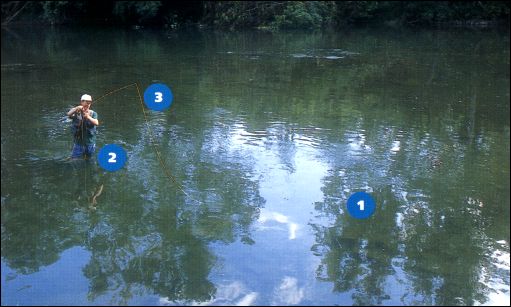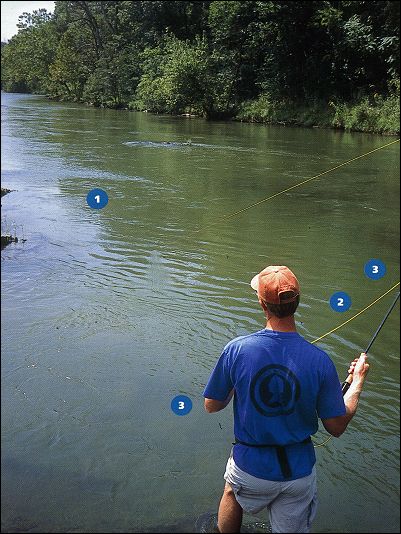Advanced Nymphing Techniques
By Harry Murray
Swing Nymphing
This method of fishing nymphs enables me to fish
them deeper than any method I've found with a floating line.
I use this in the deep pools below the riffles and the deep
cuts between river-crossing ledges, or for that matter almost
anywhere that's real deep.
Charlie Brooks, the late nymph fishing expert of West Yellowstone,
Montana, taught me this technique for fishing nymphs for trout
on the large rivers in the Rockies. After several different names
had been used to identify this technique we finally came to refer
to it as the "Brooks method". In order to master the powerful
currents in the largest rivers, Brooks used a custom-built, very
fast-sinking, thirty-foot head fly line. Since our smallmouth rivers
are not as fast as Brooks' trout rivers I've found that a floating
line does an excellent job for us. I've also made a few changes in
Brooks original method in order to fine-tune this system to our
smallmouths and thus use the term "swing nymphing" to prevent
confusion. Here is how it works.
First I identify the deep portion of the river I suspect will hold
the bass. This could be the upper reaches of a pool where the
incoming riffle empties into the pool. The water may range from
four to six feet deep over a stream bottom covered with
bushelbasket-sized boulders. The bass hold close to the stream
bottom protected by these boulders and grab any good that drifts
by - however, the big bass will seldom pull up far from the stream
bottom to grab this food. This means we should strive to drift
our nymphs right along the stream bottom.

Swing nymphing: 1)The cast is made up and across stream at
a forty-five-degree angle and the nymph is allowed to sink.
2) The rod is held up and out over the stream at a
forty-five-degree angle and the slack line is stripped in
with the line hand. 3) Swing the rod downstream ahead of
the nymph and when you feel the strike, set the hook
firmly with the rod and the line hand.
The water may range from four to six feet deep over a stream bottom
covered with bushelbasket-sized boulders. The bass hold close to the
stream bottom protected by these boulders and grab any food that
drifts by however, the big bass will seldom pull up far from the
stream bottom to grab this food. This means we should strive to
drift our nymphs right along the stream bottom.
In order to achieve this depth with my nymphs my next step is to
position myself right beside the area I plan to fish. My first
cast is made up and across stream at about a forty-five-degree
angle with about a twenty-foot cast. The nymph is allowed to
sink deeply on a slack line, do not mend the line or pick up
any slack at this stage because this will rob you of the depth
you need. After your nymph is close to the stream bottom and
starting to drift downstream extend the fly rod up and out over
the stream at a forty-five-degree angle while simultaneously
stripping in the extra slack line with your line hand. At this
point you should have a tight line from the line hand all the
way down to the nymph, but use care not to pull it up far off
the stream bottom.
As the current drifts the nymph along the stream bottom rotate
your body slightly downstream and, with the rod pointed up and
out over the river at a forty-five-degree angle, swing it
downstream at the same speed as the nymph is drifting. You
should now have a tight line on the nymph as it drifts by
straight out from where you are standing and you can feel
he strike the instant the bass takes your nymph.
Make a conscious effort to set the hook quickly and firmly
when you feel a strike. Quickly because you have only a second
to a second and a half before the bass detects the nymph as a
phoney and ejects it. Because of the downstream curve in the
belly of the line that occurs with this method, you need to
be sure your strike is telegraphed all the way down to the bass
with enough force to set the hook. (Using barbless hooks and
sharpening them often is also a great help in setting the hook.)
My second cast is made up and across stream at the same angle
as the first cast, but about five feet longer. This will allow
the nymph to drift down through the pool a little further out
than the first cast. Each successive cast is made about five
feet longer than the previous cast until you are covering all
of the water out in the pool to about forty feet from where
you are standing. Trying to cover water further out in the
pool with this method is usually not productive because the
urrents between you and your nymph pull on the line and leader
and rob you of the depth you need.
After covering this part of the pool you can wade downstream
and at about every ten feet stop and repeat this swing-nymphing
technique. This method allows your nymph to drift downstream
in an overlapping pattern that practically assures you that
every bass in front of you will see it.
Upstream Dead-Drift Nymphing
Fishing nymphs with the dead-drifting technique is entirely different
from the swing nymphing method just discussed because here you are
wading upstream, casting upstream and you are detecting the bass's
strikes by seeing them on your indicator system. The Murray's Bright
Butt Leader, with two Scientific Anglers Indicators covered in
Chapter 2, is a great help in detecting the strikes.

Upstream dead drift nymphing: 1)The cast is made upstream from
twenty to thirty feet. 2) The slack line is stripped in with
line hand at the same rate the nymph drifts downstream. 3) Set
the hook firmly with both the rod and the line hand when the
bass takes the nymph.
Reading the water in order to identify where the bass will be
holding and feeding is very important in order to be successful
when fishing nymphs upstream with the dead-drifting method. The
bass often hold on the stream bottom in the depressions around
bushelbasket-size boulders in water ranging from two to four feet
deep. Here they face into the current and intercept any nymphs
that drift by. This is very effective when fishing Hellgrammites
below riffles. Using polarized sunglasses I carefully look for
these areas as I wade upstream. From twenty to thirty feet below
them I cast my nymph straight up or up and across stream at a narrow
angle to a spot about five feet upstream of the suspected holding water.
If the river is shallow enough I may wade back and forth below
the riffles to fish with this method. If it's too deep for this
I simply fish up my side of the river carefully reading the water
for productive looking areas as I go.
Some anglers are reluctant to try upstream dead-drift nymph fishing
for bass because they feel the need to see the basses' strikes rather
than feel them makes this method too difficult to learn. Realizing
this, I have developed a simple six-step approach that will help you
master this method.
Six Steps For Mastering Upstream Dead-Drift Nymphing
1. Keep the fly line in your line hand on the presentation cast.
2. Keep the line hand within six inches of the rod hand on the
presentation cast.
3. As the forward cast begins, use your line hand to place the
line over the first or second finger of your rod hand.
4. When the forward cast turns over and is five to ten feet over
the water strip in all of the slack with your line hand. This
assures that you will have a tight line from your line hand
to the nymph as it begins drifting back downstream.
5. Facing upstream, with the rod held at a forty-five-degree
angle over the water, strip the line in with the line hand at
the same rate the nymph is drifting back downstream. Watch the
indicators or the fluorescent butt of the leader closely, when
it stops you know you have a strike.
6. Set the hook quickly by lifting the rod sharply while
simultaneously jerking back quickly with the line hand. ~ HM
Stop by the Chat Room and meet some fellow anglers. It is a nice
bunch of people - always willing to help beginners! Or just share your
fishing adventures. Fair skys and tight lines, ~ DB
Have a question? Email me!
Credit: This excerpt on nymphing techniques is just a small portion of
Harry Murray's excellent book Fly-Fishing Techniques for Smallmouth
Bass published by Frank Amato Publications. We appreciate use
permission.
Beginners Archives
|